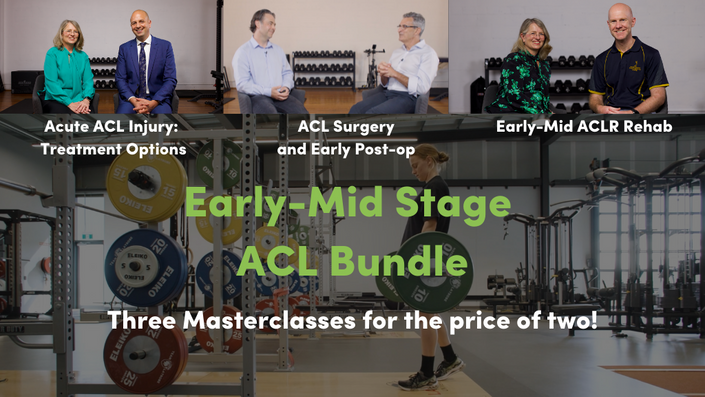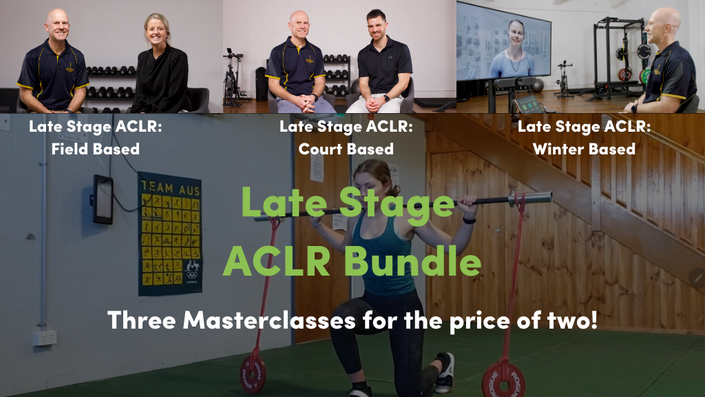Welcome back to the 4th instalment of Mick's 2 cents blog!
If you missed my first 3 blogs, you can read them here.
In the latest Podcast, Randall sat down and talked shop with ...me.
The paper that we discussed was “Progressive strength training restores quadriceps and hamstring muscle strength within 7 months after ACL reconstruction in amateur male soccer players” by Welling and colleagues (2019). The reference can be found here: (https://pubmed.ncbi.nlm.nih.gov/31425918/)
Like in all of Randall’s podcasts, there was plenty presented and discussed, but as always I want to focus this blog on a couple of key findings from this paper.
Firstly, by 10 months post-op ACLR, when compared to the control group of athletes who had never injured their ACL, over 65% of the ACLR athletes achieved >90% LSI on quad strength testing and 76% achieved >90% LSI on hamstring strength.
Furthermore, by 10 months on average the ACLR group had peak torque quads strength of their ACLR limb equal to the dominant limb of the healthy group (3.2 Nm/Kg vs 3.2 Nm/Kg) and the uninjured limb of the ACLR group on average was stronger than the non-dominant limb of the healthy control group (3.4 Nm/Kg vs 3.0 Nm/kg).
Note: based on other studies looking at normative data of healthy adult male athletes, 3.0 Nm/Kg knee extension peak torque is the current accepted standard that male ACLR athletes should be looking to achieve. For adult female ACLR athletes, they should be aiming for between 2.3 – 2.8 Nm/Kg.
These results are really important because historically, these tremendous returns of quads and hamstring strength by 10 months post-op are unheard of (especially in non-professional settings). Just 2 papers that highlight this:
- at 1 year post-op only 50% of young athletes had >90% quads strength LSI (Ithburn et al 2018)
- Those that had a Quads Tendon autograft, restoration of quads strength >90% did not occur until 2 years post-op (Johnson et al 2021).
So the million dollar question I guess for us clinicians is – “how did these amateur athletes achieve such great results?”
Well surprisingly, it wasn’t rocket science.
Which brings me to my second item up for discussion.
The great strength gains in these athletes was due to just simple and careful progressive overload training that met American College of Sports Medicine guidelines for strength in adults. These strength gains were also facilitated along the way by regular assessments (every 3 months) that aimed to address strength impairments that were found.
Even the exercises that the authors prescribed weren’t fancy; squats, RDLs, single leg squats, Bulgarian split squats, hamstring curls and knee extensions were all key exercises included in the programming.

Of course, the athletes did more than just lift weights in the gym for 10 months. They also did sport specific training and on-field rehab, but in a nutshell, in respect to their gym planning, the athletes had their rehab broken down into 4 distinct phases:
- Phase 1 (Weeks 0-4): key focus on decreasing pain, increasing ROM and normalising gait
- Phase 2 (Weeks 4–16) key focus on re-establishing load safely into the gym with commonly used gym exercises with low weight and high reps 3x per week (2x15-25 reps per exercise)
- Phase 3 (weeks 16 – 28) key focus on restoring strength and hypertrophy using commonly used rehab exercises 2x per week (3-4 sets of 8-12 reps per exercise), and also have 1x light day per week (2x15-25 reps per exercise)
- Phase 4 (weeks 28-40) key focus on restoring power using commonly used exercises 2x per week (5 sets of 3 reps per exercise) and also have 1x light day per week (2x15-25 reps per exercise).
By having the program broken down in this fashion, it allowed the athletes to have their quads and hamstrings regularly re-assesed (amongst other outcome measures) to be then carefully progressed the next phase so they could continue to grow and get stronger and more powerful and be much better equipped for a return to sport.
Which is just good clinical practice right?
So in wrapping up my blog – I hope you have enjoyed it by the way - here are my 2 cents regarding this ground-breaking paper:
1) Quads and hamstring strength restoration doesn’t just naturally return by 12 months. Even with a “good” rehab program, there’s a fair chance that it may not be enough to restore quads strength >90% symmetry. Rehab needs to be progressive in nature and aimed at not only restoring muscle size and strength, but power and rate of force development (as seen in the last 3 months of this program by Welling et al).
2) ACLR rehab should not be full of circus tricks and “cool videos” you saw on YouTube. The tremendous results seen here in this population were achieved by consistent and progressive overload training with commonly used gym exercises.
3) Lastly, don’t be afraid to load the ACLR knee. The knee will tell you if its unhappy with the load you’re trying to throw at it by swelling and/or the person having an increase in pain within the next 24-48hrs after the session. Unfortunately in my clinical practice I see far too much “under-loading” of the ACLR athlete as opposed to too much aggressive, early loading. If you’re not sure when to load and how much, don’t be afraid to reach out to exercise professionals who do how to load appropriately and work together as a team to achieve great results for your athlete.
Journal Club with Randall Cooper
Mick's 2 Cents are based on the latest episodes of Journal Club with Randall Cooper.
These blogs delve into Mick's own perspective of each topic from the podcast.
If you'd like to listen to the full 15 minute podcast with Randall and Shona, click on one of the links below:



